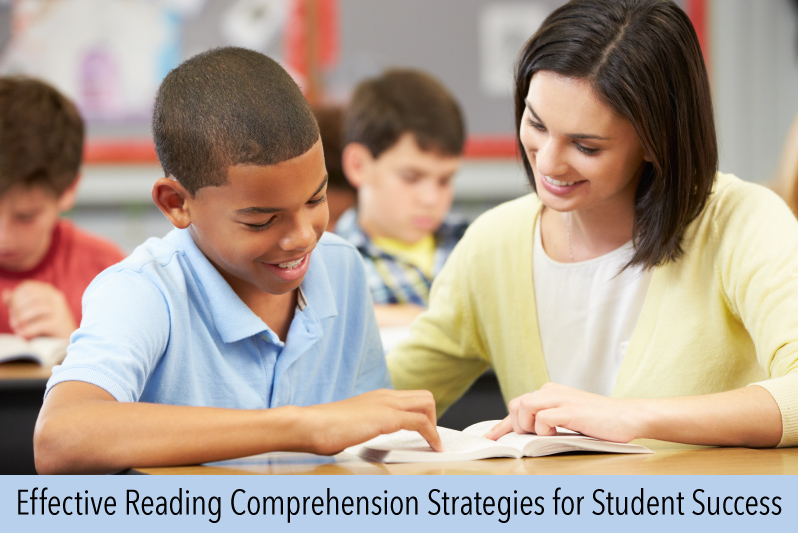Effective Reading Comprehension Strategies for Student Success

Reading comprehension requires the ability to understand and interpret text including using key skills like memory, vocabulary, and critical thinking. Some traditional teaching methods may address these areas, however, Lindamood-Bell’s unique sensory-cognitive approach focuses on explicitly developing concept imagery—the ability to create an imaged gestalt (whole) from oral and written language. Concept imagery is the foundation for reading comprehension and critical thinking for individuals of all ages. The following sections offer practical tips for educators working with students at all levels and provide a foundation for understanding weak reading comprehension, including identifying its underlying causes.
Understanding Reading Comprehension
Reading comprehension involves actively engaging with written material, making connections, and deriving meaning from the text. This skill is crucial for academic success and lifelong learning. To comprehend what we read, one must have adequate concept imagery—the ability to create an imaged whole from written language. At Lindamood-Bell, we provide evidence-based instruction that develops this imagery-language foundation. According to Nanci Bell, co-founder of Lindamood-Bell and author of the Visualizing and Verbalizing® (V/V®) program, “Clinical research and experience over the last 30 years indicate there is a separate comprehension weakness that is rarely identified. This weakness often undermines the reading process…It is weakness, based in the sensory system, in creating an imaged gestalt.”
Students with weak reading comprehension may be able to decode words accurately but cannot understand what they read. This weakness also affects oral language comprehension. For example, students may struggle with following directions and have poor short-term and long-term memory skills. Unfortunately, these weaknesses can come across as a lack of effort or motivation on the part of the student and may go undiagnosed.
Difficulty creating an imagined gestalt–weak concept imagery– causes individuals to get only “parts” of information they read or hear, not the whole. Individuals of all ages may experience the symptoms of a weakness in concept imagery. This causes weakness in:
- Reading comprehension
- Listening comprehension
- Critical thinking and problem-solving
- Following directions
- Memory
- Oral language expression
- Written language expression
- Grasping humor
- Interpreting social situations
- Understanding cause and effect
The Visualizing and Verbalizing program develops concept imagery—the ability to create an imagined or imaged gestalt from language—as a basis for comprehension and higher-order thinking. The development of concept imagery improves reading and listening comprehension, memory, oral vocabulary, critical thinking, and writing.
Eight Tips to Enhance Reading Comprehension Strategies

Have you helped students improve their phonemic awareness, phonics, and word recognition, only to see them struggle with reading comprehension? Many students experience reading comprehension weakness despite having adequate decoding and vocabulary skills. While educators often implement various comprehension strategies, they may sense something crucial is still missing.
Lindamood-Bell’s sensory-cognitive approach to language and literacy addresses this gap by focusing on concept imagery. This process, known as imaging a gestalt, forms the foundation for reading and oral language comprehension.
The National Reading Panel Report (2000) identifies imagery as a research-based strategy for improving comprehension. Applying concept imagery to reading comprehension helps students build mental models that support higher-order thinking skills like identifying the main idea, making inferences, drawing conclusions, predicting outcomes, and evaluating information. Effective strategies for developing these mental models include checking for vocabulary, activating background knowledge, and questioning students about what the words they read make them picture.
These eight tips will help you apply concept imagery to reading comprehension.
- Introduce explicit instruction to develop concept imagery.
- Pre-check unknown vocabulary.
- Activate background knowledge.
- Monitor for comprehension.
- Ask students for a word summary.
- Check for imagery and understanding.
- Use imagery for higher-order thinking questions.
- Model the thinking process.
Introduce Explicit Instruction to Develop Concept Imagery
Improving reading comprehension starts with explicit instruction in concept imagery—teaching students how to create mental images of the language they read. Often, we assume that students can create mental images when this is not the case.
Introduce the idea of imagery or visualization with a student-friendly term like “picture.” Describe how words on the page turn into pictures in their mind. When a student reads silently or aloud, ask them what the words make them picture. Be specific. For example, ask, “What did you picture for the skyscraper?” or “What do you picture for the people signing the Declaration of Independence?” As Nanci Bell states in the VV® program manual, for many students, explicit instruction will need to start from the one-word level, to “develop the student’s ability to create mental representations for a word, thus laying the foundation for more language: a phrase, a sentence, or a paragraph.”
Pre-check Unknown Vocabulary
Scan the text and identify key terms that may be challenging or unknown. Ask your students if they have a picture for those words. Use an age-appropriate dictionary to teach them the meanings. Help students develop a specific, concrete mental image for each word by providing them with choices, such as “Is the man’s sweater blue or brown,” or “Do you picture a young woman or an old woman?”
At Lindamood-Bell, we recognize the importance of vocabulary in reading comprehension. Our evidence-based program, Visualizing and Verbalizing, develops vocabulary and reading comprehension using concept imagery techniques.
Activating Prior Knowledge
Prior knowledge plays a role in reading comprehension. It refers to the information and experiences readers already possess about a topic. Activating prior knowledge helps students make connections between what is known and new information, enhancing understanding.
Check for imagery and understanding of words or concepts that may activate prior knowledge. For example, if students are reading a story that takes place on a deserted island, you could ask your students if they have ever been to an island, do they know what to picture for an island, and how they can picture it as deserted. Again, ask questions that include choices. For example, “Do you picture the island covered in sand or rocks?”
Monitoring Comprehension
Monitoring comprehension is a crucial skill for effective reading. It involves being aware of one’s understanding of the text and actively taking steps to clarify and improve comprehension.
To help develop this skill, first have students read text aloud so you can also monitor for decoding accuracy and fluency. Prompt students to actively check they are visualizing the text as they read. If they miscall a word that affects the meaning, your first question should be, “What does that make you picture? Does that make sense?”
Readers can imagine characters, settings, and events, connecting with the text on a deeper level.
Ask Students for a Word Summary
After reading the text, ask the student to give a verbal summary in their own words (a word summary). This will be your first assessment of whether they recalled the relevant details and sequence and understood the passage. Students may initially struggle with accurate word summaries, perhaps only giving a few details, but improve with practice and more attention to their imagery. As they become more skilled with verbal word summaries, extend the lesson to written word summaries.
Check for Imagery and Understanding
Teach students to visualize the text and create mental images. This technique enhances reading comprehension and retention of information. Ask students questions about key information from the text. Teach students to actively check their imagery and question them for important details to make their image concrete, such as size, shape, color, movement, and background.
Use Imagery for Higher-Order Thinking Questions
Prompt students to use their imagery as a foundation for higher-order thinking skills. Higher-order thinking (HOT) questions require a more complex understanding of the text beyond basic facts and details. These include Main Idea, Inference, Conclusion, and Prediction. Prompt students to use their imagery as a foundation for higher-order thinking beginning with the main idea. For example, “Based on what you pictured, what do you think the main idea is?”
Model the Thinking Process
Demonstrate effective reading comprehension strategies by thinking aloud while reading. This allows learners to observe and internalize the thinking process.
Provide examples from your imagery, especially for more complex and abstract text. When possible, use new vocabulary to increase your students’ word knowledge. Start your example with the words, “I pictured. . .”
To learn more about using imagery to enhance comprehension strategies, access our Toolkit for Educators to download our guide, “8 Tips to Enhance Comprehension Strategies.”
Case Study: Improving Reading Comprehension for Elementary School Students

Students who struggle with comprehension benefit from the Visualizing and Verbalizing (VV) for Language Comprehension and Thinking program. The program provides explicit and systematic instruction for developing concept imagery and has been shown to significantly improve reading and listening comprehension. Fort Smith Public Schools in Fort Smith, Arkansas serves a large percentage of students who are at risk of reading failure. During the 2020-21 school year, Fort Smith Public Schools implemented Lindamood-Bell instruction to address the specific needs of this student population. A group of 97 students received an average of 52 hours of Visualizing and Verbalizing instruction. Instruction was delivered by Fort Smith Public Schools’ teachers who received professional development in the programs. Student gains were measured with a battery of assessments.

RESULTS: On average, Visualizing and Verbalizing students achieved statistically significant, large standard score gains in Reading Comprehension. The percentile growth shows these students moved from below the normal range into the normal range (25th-75th percentile). The results of this study illustrate that instruction in the Visualizing and Verbalizing program developed by Lindamood-Bell’s founders leads to improved comprehension, which is essential to achieving success with school curricula.
PROFILE: Reading Comprehension
Number of Students: 97
Average Age: 12.1
Average Hours of Instruction: 52
Lindamood-Bell Programs Implemented: Visualizing and Verbalizing
Outcome Measures:
• Peabody Picture Vocabulary Test (PPVT)-4th/5th (vocabulary)
• Gray Oral Reading Tests (GORT)-4th (accuracy, fluency, comprehension)
View more results and case studies of our work with schools.
Educator Insights
Listen to educators from Fort Smith Public Schools share how Lindamood-Bell Professional Development has helped them make a meaningful impact on their students’ learning.
Support for Educators

Ready to go beyond the tips in this blog? Lindamood-Bell proudly offers educators professional development in our highly successful and proven programs. Our workshops, available both in person and live online, provide in-depth training to enhance instructional practices and improve student outcomes. Schools can partner with us for in-services, job-embedded coaching, and comprehensive school partnerships.
Contact Lindamood-Bell today. Call us at 800-233-1819 OR Click here to schedule a brief consultation with a program expert to discuss your intervention needs. We are excited to teach you how to improve your students’ reading comprehension and unlock their full potential!






